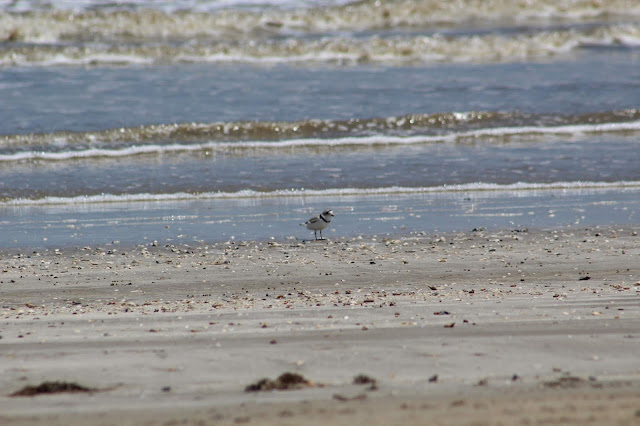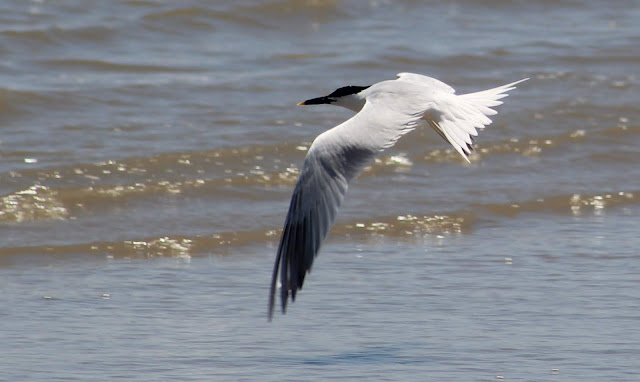At this point and time on our trip, we had surpassed three hundred species for Texas and it was our ninth day of the trip. By reading some of the birds that we could possibly see at Bolivar Flats, I knew that it would produce a few life birds as well as a handful of birds for our Texas lists. Bolivar Flats Shorebird Sanctuary is recognized as an Important Bird Area (IBA) and it only allows foot travel along the beach areas to avoid disrupting crucial habitats nearby. The Sanctuary has a variety of water levels and habitats that include salt marsh, mud flats, beach, and open ocean. And it also has an incredible variety of birds. Shorebirds, gulls, terns, herons, and more. After reading over Josh's itinerary and the possible highlight birds we could see at Bolivar Flats, some of the species I was hoping we would see included Piping Plover, Wilson's Plover, Sandwich Tern, and the attention-grabbing Magnificent Frigatebird.
Once we got to Bolivar Beach, we would drive along a dirt road that parallels the beach for about a half-mile until the Sanctuary is reached. When the Sanctuary was accessed, it was fenced off and there was a parking area. We parked and would walk out into the habitat for the rest of the time. The "entrance road" itself was good, and we stopped often. Laughing Gulls were everywhere.
Laughing Gulls are three-year gulls in their growth to reach adulthood, and they are named for their "laughing" like call. They are extremely common along the Gulf Coast, and it was fun to see them in numbers like this after seeing very few of them prior to this trip.
A few Herring Gulls were also present.
Ruddy Turnstones and Sanderlings lined the beach lines.
As I drove and scanned, a small plover caught my attention. And it looked like a particular bird I was wanting to see...
Yes, yes, yes! It was my first ever Piping Plover.
It was a good thing that this Piping Plover was along the edge of the beach. Because of that, it was easier for me to spot in a moving car. Otherwise, a beach colored bird running around in the sand would have blended in perfectly with it's surroundings. We stopped and took some pictures of the bird and enjoyed it for a minute. Piping Plovers are an endangered species because of habitat destruction during their breeding season. They have habitat protections now where they breed along the Atlantic Coast and on salt flats near lakes and rivers on north-central United States prairies.
This adult Piping Plover made for a straightforward identification with it's complete black chest band, bright orange legs, black line across forehead, sandy beach coloration, and short stubby bill (Semipalmated and Snowy Plovers have longer bills).
Along the road until we'd get out and walk there were also plenty of Least Terns. Little did I know, there would be more and more of these small birds. A lot more of them...
Once we officially parked and walked through the gates to enter into Bolivar Flats Shorebird Sanctuary, we had just over an hour to bird. The habitats and location that we stepped into was nothing short of incredible. Birds were everywhere we looked, including high numbers of those Least Terns.
Scan away birders. Bolivar Flats Sanctuary isn't just an escape for birds, but is for birders too.
I love it when birds within the same family, but of several different species, flock up together. As we walked up closer to the tern flocks, I enjoyed photographing these Common, Royal, and Sandwich Terns together.
As I got to see Sandwich Terns a few times on South Padre Island, I got the much closer looks that I desired as I strolled the Bolivar beach. What a cool looking bird.
True to the location's name, Bolivar Flats harbored a lot of shorebirds. We had over twenty species in our visit. One of the twenty were a handful of Dunlin. These shorebirds feed by probing into the water and mudflats for their food source variety. Something interesting I just learned about Dunlins as that they can fly at speeds of more than a hundred miles per hour. That's faster than I'll ever be able to go...
A scan by Caleb into a distant flock of mixed shorebirds and terns on a mudflat resulted in him announcing a Wilson's Plover, which was a second lifer from Bolivar Flats. Looking through Caleb's scope revealed the small but robust and thick-billed plover. As we got closer, the Wilson's Plover went absent on us. Strolling the beach is the best way to stumble upon a Wilson's Plover, and as we continued on along Bolivar, Caleb spied another Wilson's Plover much closer than the previous one.
Wilson's Plovers are fairly common breeders on southeastern beaches from the Gulf of Mexico northeast and up into the Atlantic Coast. They are permanent residents along the beaches and coasts of Florida.
As we watched the Wilson's Plover at close range, things got interesting when we saw that it had a mate with it. They used the distraction display on us that other plovers (such as Killdeer) use in attempts to distract us away from where we are to another point. It was obvious that these two Wilson's Plovers had most likely laid eggs right in the thirty foot radius from where we were in accordance to them.
After viewing the Wilson's Plovers which was also a lifer for Caleb and Josh, we looked down the beach further to see bird numbers that were more impressive than they already were. A scan of distant shorebirds gave us a few American Oystercatchers.
A small pool of water off to the side gave us these Short-billed Dowitchers, Lesser Yellowlegs, and Least Sandpipers.
Caleb and I had this Roseate Spoonbill fly by. I wish it would've stopped, because it sure was brighter than most of the other Spoonbills we were seeing on the trip.
I really enjoyed coming to a point along the shore where groups of smaller plovers congregated together. There were Snowy, Piping, and Semipalmated Plovers within incredibly close range of each other, and the latter two in photographic range together. In the next photograph, there are eight Semipalmated Plovers and three Piping Plovers. The Snowy Plovers stuck further away from the water. Also in this photograph is a Least Sandpiper, a few Ruddy Turnstones, and a few peeps that are hard to discern.
Here is a picture of one of the Snowy Plovers, as well as a few pictures of Piping and Semipalmated Plovers side-by-side. I really wanted a Snowy Plover to go in and join the other two...
An impressive tern flock right along the shore adjacent to us consisted of hundreds of Common Terns, Black Skimmers, and Royal Terns.
It was really impressive when the flock spooked and flew up. I've never seen so many Common Terns!
Black Terns were in midst of the flock too, as well as some Sandwich Terns. When the mass landed I snapped a photo. With a careful eye you can find Common, Black, Sandwich, Royal, and Caspian Terns. Laughing Gulls, American Avocets, Brown Pelican, Black Skimmer, and Great Blue Heron are also in this photo.
Here's a shorebird mass. With a single Common Tern mixed in.
Things got really fun and I was surprised when Caleb called out, "Hey guys, I've got a Buff-breasted Sandpiper!".
A Buff-breasted Sandpiper, wow! And we couldn't forget that we had put in a good searching effort the night before for this species. It was odd that one showed up in front of us at Bolivar Flats. Maybe it wasn't so odd, Caleb spied it and it's a regular thing for Caleb to pull out birds like this.
Like most shorebirds, Buff-breasted Sandpiper is a long distance migrant. This one was making a stop on it's way to the far North, where it breeds in northern Alaska and Canada in arctic tundra. Buff-breasted Sandpipers don't use mudflats in migration much like other shorebirds do, but they would usually rather use wet fields, turf farms, and short grass and plowed fields for foraging in migration.
Behavior wise, Buff-breasted Sandpipers are odd. They are often tame and approachable, and tend to run away when alarmed like a plover rather than fly away like most sandpipers. It's short bill and plain expression give it a dove-like head appearance.
 |
| Buff-breasted Sandpiper with Semipalmated Sandpiper (above and below) |
The Buff-breasted Sandpiper was probably the biggest highlight at Bolivar, I loved the way it showed up. It was a lifer for me, Caleb, Josh, and I think it was for Liam too. David had had it before. During our trip, I had three lifers from the shorebird family that I had a decent chance of seeing in Texas, and they were the three lifers I got at Bolivar: Piping Plover, Wilson's Plover, and Buff-breasted Sandpiper. What a stop it was. Meanwhile, we still had more scanning to do. Brown Pelicans are always a sight along the coast.
Some of them had a light-morph Reddish Egret behind them..
A red morph Reddish Egret was around too. Gosh, they are freaking cool.
On the walk back, Bolivar Flats was still the tern show. Here is a Least Tern with it's catch.
Here is Dan and Ann scanning the terns and shorbs.
The terns and Black Skimmers continued to thrill.
 |
| One of two Franklin's Gulls detected |
 |
| Least Terns and Black-bellied Plover |
In only one hour of birding, like we spent at this awesome spot, a lot can happen! We had 21 shorebirds: American Avocet, American Oystercatcher, Snowy Plover, Wilson's Plover (8), Semipalmated Plover, Piping Plover (3), Black-bellied Plover, Marbled Godwit, Ruddy Turnstone (33), Red Knot (2), Sanderling (130), Dunlin (9), Least Sandpiper, White-rumped Sandpiper, Buff-breasted Sandpiper, Semipalmated Sandpiper (35), Short-billed Dowitcher (32), Wilson's Phalarope (18), Spotted Sandpiper, Greater Yellowlegs, Willet (Eastern and Western), and Lesser Yellowlegs.
Terns were the other major part of the show. We had about 750 Least Tern, 4 Caspian Tern, 15 Black Tern, 1600 Common Tern, 2 Forster's Tern, 80 Royal Tern, 45 Sandwich Tern, and 800 unidentified tern species.
Other awesome highlights in nearly 60 species were Black Skimmer, Tricolored Heron, Reddish Egret, Roseate Spoonbill, and Crested Caracara.
Bolivar Flats Shorebird Sanctuary was a massive observation put into a single hour. It was fun to see incredible numbers of birds that were present, and get three life birds in the shorebird department in the midst of it all. We'd hit the road to go further northeast into Texas from this point, and the story will pick up there on my next post. Hopefully I'll get to bird Bolivar Flats again someday, where impressive shorebird and tern numbers merge together.













































































No comments:
Post a Comment